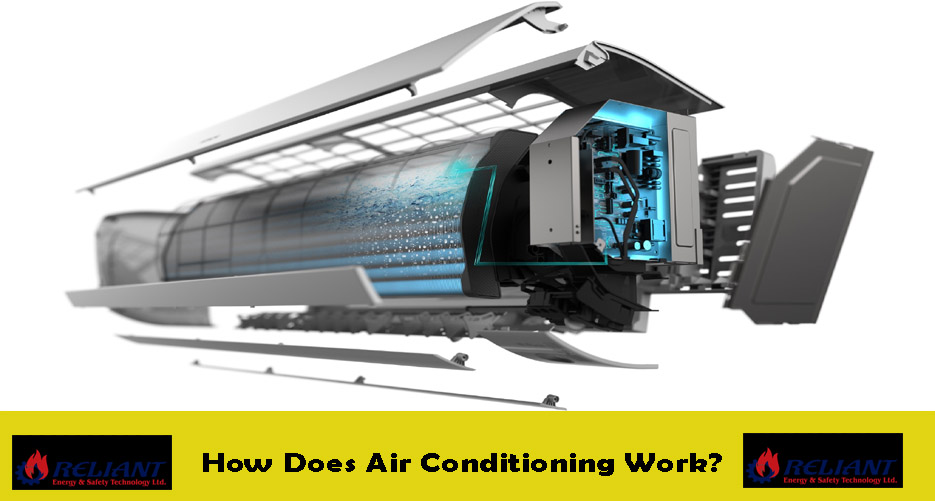Air conditioning is a common feature in many homes and buildings, especially in hot and humid climates. It is an essential technology that helps to regulate indoor temperature and humidity levels, providing comfort and convenience to occupants. However, despite its widespread use, many people do not fully understand how air conditioning works.
At its core, air conditioning is a system that removes heat and moisture from indoor air, replacing it with cooler, drier air. This process is achieved through a combination of mechanical and chemical processes, including compression, expansion, and evaporation. The key components of an air conditioning system include a compressor, a condenser, an evaporator, and a refrigerant, which work together to cycle the refrigerant fluid through the system and transfer heat from inside to outside. Read on to learn more about How Does Air Conditioning Work?
Understanding the Basics of Air Conditioning
Air conditioning is a system that helps regulate the temperature, humidity, and air quality within a building or vehicle. It works by taking heat and moisture out of the air and then putting the cool, dry air back into the room.
The basic components of an air conditioning system include a compressor, a condenser, an evaporator, and a refrigerant. The compressor is responsible for compressing and circulating the refrigerant, which is a chemical that absorbs and releases heat as it changes from a liquid to a gas and back again. The condenser releases the heat absorbed by the refrigerant, while the evaporator absorbs heat from the air and removes moisture.
Air conditioning systems can be either centralized or decentralized. Centralized systems are typically used in larger buildings and consist of a single unit that cools and circulates air throughout the entire building. Decentralized systems, on the other hand, are used in smaller spaces and consist of individual units that are installed in each room or area that needs to be cooled.
How Does Air Conditioning Work?
Air conditioning works by circulating refrigerant through a closed system of coils. The refrigerant absorbs heat from indoor air, then releases it outside, cooling the indoor space. A fan blows the cooled air back inside, regulating temperature and humidity for comfort. This process repeats to maintain desired conditions.
Types of Air Conditioning Systems
There are different kinds of air conditioning systems to meet different needs. Window air conditioners are small and best for single rooms. Split systems, on the other hand, have both indoor and outdoor units that can be used to cool single rooms or larger areas. Central air conditioning uses ducts to cool the whole house or building, so the temperature is always the same. Mini-split air conditioners that don’t have ducts are useful for adding on rooms or for homes that don’t have ductwork. Portable air conditioners can be moved to cool specific areas, and evaporative coolers cool the air by letting water evaporate. This makes them good choices for dry climates because they use less energy. Each type has its own benefits that suit different tastes and needs.
Components of an Air Conditioning System
An air conditioning system is composed of four main components: the condenser, evaporator, compressor, and expansion valve. Each component plays a crucial role in the cooling process and the overall efficiency of the system.
Condenser
The condenser is located on the outside of the building and is responsible for releasing the heat that is absorbed by the refrigerant. It is usually a large metal box with a fan that blows air over the coils. As the refrigerant flows through the condenser, it releases the heat it has absorbed from inside the building, and the fan blows this heat away into the outside air.
Evaporator
The evaporator is located inside the building and is responsible for absorbing the heat and humidity from the indoor air. It is usually a metal box with a fan that blows air over the coils. As the refrigerant flows through the evaporator, it absorbs the heat and humidity from the indoor air, and the fan blows this cooled and dehumidified air back into the building.
Compressor
The compressor is located outside the building and is responsible for compressing the refrigerant and pumping it through the rest of the system. It is usually a large metal cylinder that contains a motor and a pump. As the refrigerant flows through the compressor, it is compressed into a high-pressure, high-temperature gas, which is then pumped through the rest of the system.
Expansion Valve
The expansion valve is located between the evaporator and the compressor and is responsible for regulating the flow of refrigerant through the system. It is usually a small metal valve that controls the pressure and temperature of the refrigerant as it flows through the system. As the refrigerant flows through the expansion valve, its pressure and temperature are reduced, which allows it to absorb more heat and humidity from the indoor air.
In summary, an air conditioning system is composed of four main components: the condenser, evaporator, compressor, and expansion valve. Each component plays a crucial role in the cooling process, and the overall efficiency of the system depends on the proper functioning of each component.
Energy Efficiency and Air Conditioning
Air conditioners can use a lot of energy, which can lead to high electricity costs and more carbon dioxide in the air. So, when choosing an air conditioner for your home or office, it’s crucial to think about how much energy it uses.
The Seasonal Energy Efficiency Ratio (SEER) is a way to figure out how energy-efficient an air conditioner is. The more efficient an AC unit is, the higher the SEER number. By rule, a unit must have a SEER rating of at least 13, but some have ratings as high as 25. Long-term energy savings can be huge if you buy a unit with a higher SEER rating.
The size of the air conditioning unit is another thing to think about. A unit that is too big will not only use more energy, but it won’t cool the room well enough, causing pain and wasting energy. On the other hand, a unit that is too small will have trouble cooling the space, which will cause it to use more energy as it tries to make up for it.
Keeping up with the unit’s repair is another way to make it use less energy. This means cleaning or replacing the air filter, checking the amount of refrigerant, and making sure the unit is sealed and insulated well.
Conclusion
In the end, air conditioning is an important tool that plays a big part in modern life. It helps to control the temperature inside, get rid of damp, and improve the quality of the air. Air conditioners work by taking the heat out of the air inside and sending it outside. A refrigerant that moves through the system helps this process along.
There are different kinds of air cooling systems, such as central air conditioning, window units, and portable units. Depending on the user’s wants and budget, each type has its own pros and cons. It’s important to choose the right kind of air conditioning system so that you can be as comfortable as possible and use the least amount of energy.
Air cooling systems need to be serviced regularly to work well and last as long as possible. This means cleaning or replacing the air filters, checking the amount of refrigerant, and looking for leaks or damage in the system. It is also important to use the right size air conditioning unit for the space being cooled. A unit that is too small or too big for the area can waste energy and cause costs to go up.

